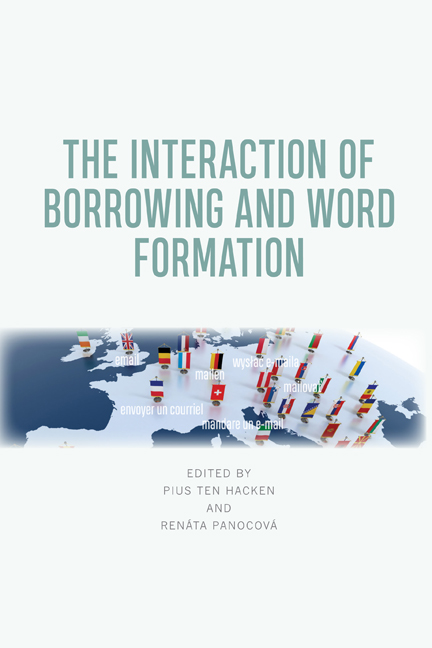Book contents
- Frontmatter
- Contents
- List of Figures and Tables
- List of Contributors
- Preface
- List of ISO-639 Language Codes
- Introduction
- 1 Word Formation, Borrowing and their Interaction
- Part I Compounding
- 2 Compounding and Contact
- 3 Neoclassical Compounds between Borrowing and Word Formation
- 4 Borrowed Compounds, Borrowed Compounding – Portuguese Data
- 5 Compound Calques in an Eighteenth-Century German-Lithuanian Dictionary
- 6 (Pseudo-)Anglicisms as Nominal Compounds in Italian
- Part II Affixation
- 7 The Role of Borrowing in the Derivation of Passive Potential Adjectives in Polish
- 8 How an ‘Italian’ Suffix Became Productive in Germanic Languages
- 9 The Suffixes -ismus and -ita in Nouns in Czech
- 10 The Interaction between Borrowing and Word Formation: Evidence from Modern Greek Prefixes
- Part III Naming in Minority Languages
- 11 Loanword Formation in Minority Languages: Lexical Strata in Titsch and Töitschu
- 12 Examining the Integration of Borrowed Nouns in Immigrant Speech: The Case of Canadian Greek
- 13 Interaction among Borrowing, Inflection and Word Formation in Polish Medieval Latin
- Conclusion
- 14 Trends in the Interaction between Borrowing and Word Formation
- Author Index
- Subject Index
8 - How an ‘Italian’ Suffix Became Productive in Germanic Languages
Published online by Cambridge University Press: 22 September 2020
- Frontmatter
- Contents
- List of Figures and Tables
- List of Contributors
- Preface
- List of ISO-639 Language Codes
- Introduction
- 1 Word Formation, Borrowing and their Interaction
- Part I Compounding
- 2 Compounding and Contact
- 3 Neoclassical Compounds between Borrowing and Word Formation
- 4 Borrowed Compounds, Borrowed Compounding – Portuguese Data
- 5 Compound Calques in an Eighteenth-Century German-Lithuanian Dictionary
- 6 (Pseudo-)Anglicisms as Nominal Compounds in Italian
- Part II Affixation
- 7 The Role of Borrowing in the Derivation of Passive Potential Adjectives in Polish
- 8 How an ‘Italian’ Suffix Became Productive in Germanic Languages
- 9 The Suffixes -ismus and -ita in Nouns in Czech
- 10 The Interaction between Borrowing and Word Formation: Evidence from Modern Greek Prefixes
- Part III Naming in Minority Languages
- 11 Loanword Formation in Minority Languages: Lexical Strata in Titsch and Töitschu
- 12 Examining the Integration of Borrowed Nouns in Immigrant Speech: The Case of Canadian Greek
- 13 Interaction among Borrowing, Inflection and Word Formation in Polish Medieval Latin
- Conclusion
- 14 Trends in the Interaction between Borrowing and Word Formation
- Author Index
- Subject Index
Summary
This chapter discusses the complicated interplay between some examples of borrowing and subsequent word formation. It will demonstrate how speakers of Dutch and German re-analyse disyllabic forms, which have recently been borrowed from American English, and how they subsequently use the pattern applied in these clippings more widely, which results in a word formation process that resembles clipping and subsequent suffixation as it appears in American English. However, the application differs. Dutch, for example, borrowed disyllabic models such as lesbo and afro on the one hand and kiddo and creepo on the other hand. The first two lexemes can be described as monosyllabic clipped forms to which subsequent suffixation applied, while in the latter two suffixation applied to a monosyllabic base word. However, in Dutch the new word formation process also accepts disyllabic and trisyllabic base words and thus results in trisyllabic and quadrisyllabic words such as gewono and positivo.
In the first part of this chapter, traditional monosyllabic clipping in English, Dutch and German is discussed. In the second part, clipping is compared with hypocoristic formations in German and English. In the third part, the focus is on recent disyllabic forms ending in unstressed -o. In this section it will also be demonstrated how the -o pattern has been borrowed in Dutch and German. In addition, some data from Swedish will be presented to support the claim made in this chapter. The data discussed here come from the literature about clipping and from focused Google searches by the author.
Clipping: general
In this section, first a few remarks from the literature about clippings will be presented. Subsequently a preliminary analysis of different types of English clipping follows. Finally, examples from languages such as Dutch and German will be discussed.
Arbitrariness
Stockwell and Minkova (2001: 10) devote a short paragraph to clipping, which they call ‘creation by shortening’, in which the authors state:
Shortening may take any part of a word, usually a single syllable, and throw away the rest, like quiz from inquisitive, phone from telephone, plane from airplane, flu from influenza.
- Type
- Chapter
- Information
- The Interaction of Borrowing and Word Formation , pp. 140 - 161Publisher: Edinburgh University PressPrint publication year: 2020



